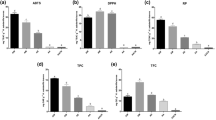Abstract
The antioxidant capacity of aqueous extracts from yerba mate and some of its polyphenolic components, namely, quercetin, rutin, chlorogenic and caffeic acids, was studied. Aqueous extracts from mate discolored the cation radicals of 2,2'-azinobis(3-ethylbenzothiazoline-6-sulfonic acid) in a dose-dependent manner and caused a latent period of luminol chemiluminescence induced by 2,2'-azobis(2-amidinopropane) dihydrochloride. The following sequence of the studied substances in order of decreasing antioxidant capacity: quercetin, rutin, chlorogenic acid, and caffeic acid occurred in both model systems, represented as trolox equivalents. The antioxidant capacity of quercetin was higher than that of chlorogenic and caffeic acids. An increase was found in the antioxidant capacity of blood plasma in healthy volunteers which was assessed with the chemiluminescent system at 1 and 2 h after a single consumption of a tea made from 8 g of mate. The results show that aqueous extracts from yerba mate can be used to create phytopreparations with antioxidant properties.






Similar content being viewed by others
REFERENCES
L. Zuo, E. R. Prather, M. Stetskiv, et al., Int. J. Mol. Sci. 20 (18), 4472 (2019).
A. Singh, R. Kukreti, L. Saso, and S. Kukreti, Molecules 24 (8), 1583 (2019).
I. Uchmanowicz, Adv. Exp. Med. Biol. 1216, 65 (2020).
A. Chandrasekara and F. Shahidi, J. Tradit. Complement. Med. 8 (4), 451 (2018).
S. Dudonne, X. Vitrac, P. Coutiere, et al., J. Agric. Food Chem. 57 (5), 1768 (2009).
K. A. Berte, M. R. Beux, P. K. Spada, et al., J. Agric. Food Chem. 59 (10), 523 (2011).
C. I. Heck and E. G. de Mejia, J. Food Sci. 72 (9), R138 (2007).
N. Bracesco, A. G. Sanchez, V. Contreras, et al., J. Ethnopharmacol. 136 (3), 378 (2011).
A. T. Valduga, I. L. Goncalves, E. Magri, and J. R. Delalibera Finzer, Food Res. Int. 120, 478 (2019).
R. Y. Gan, D. Zhang, M. Wang, and H. Corke, Nutrients 10 (11), 1682 (2018).
D. H. Bastos, L. A. Saldanha, R. R. Catharino, et al., Molecules 12 (3), 423 (2007).
M. Bixby, L. Spieler, T. Menini, and A. Gugliucci, Life Sci. 77 (3), 345 (2005).
C. Anesini, S. Turner, L. Cogoi, and R. Filip, LWT — Food Sci. Technol. 45, 299 (2012).
M. Bojić, V. Simon Haas, D. Sarić, and Z. Maleš, J. Anal. Methods Chem. 2013, 658596 (2013).
G. R. Schinella, G. Troiani, V. Davila, et al., Biochem. Biophys. Res. Commun. 269 (2), 357 (2000).
A. Gugliucci, Biochem. Biophys. Res. Commun. 224 (2), 338 (1996).
N. Bracesco, M. Dell, and A. Rocha, J. Altern. Complement. Med. 9 (3), 379 (2003).
F. Martins, A. J. Suzan, S. M. Cerutti, et al., Br. J. Nutr. 101 (4), 527 (2009).
L. Bravo, R. Mateos, B. Sarria, et al., Fitoterapia 92, 219 (2014).
L. F. Gonzalez Arbelaez, J. C. Fantinelli, A. Ciocci Pardo, et al., Food Funct. 7 (2), 816 (2016).
A. C. Colpo, M. E. de Lima, M. Maya-Lopez, et al., Appl. Physiol. Nutr. Metab. 42 (11), 1172 (2017).
R. L. Matsumoto, D. H. Bastos, S. Mendonca, et al., J. Agric. Food Chem. 57 (5), 1775 (2009).
A. M. Becker, H. P. Cunha, A. C. Lindenberg, et al., Plant Foods Hum. Nutr. 74 (4), 495 (2019).
B. C. Boaventura, P. F. Di Pietro, A. Stefanuto, et al., Nutrition 28 (6), 657 (2012).
W. Y. Huang, P. C. Lee, J. C. Hsu, et al., Sci. World J. 2014, 768742 (2014).
R. G. Peres, F. G. Tonin, M. F. Tavares, and D. B. Rodriguez-Amaya, Molecules 18 (4), 3859 (2013).
R. Re, N. Pellegrini, A. Proteggente, et al., Free Radic. Biol. Med. 26 (9-10), 1231 (1999).
Yu. O. Teselkin, I. V. Babenkova, and A. N. Osipov, Biophysics (Moscow) 64 (5), 708 (2019).
M. Gomez-Juaristi, S. Martinez-Lopez, B. Sarria, et al., Food Chem. 240, 1028 (2018).
N. Erkan, G. Ayranci, and E. Ayranci, Food Chem. 110 (1), 76 (2008).
L. M. Magalhaes, M. A. Segundo, S. Reis, and J. L. Lima, Anal. Chim. Acta 613 (1), 1 (2008).
R. Apak, M. Ozyurek, K. Guclu, and E. Capanoğlu, J. Agric. Food Chem. 64 (5), 997 (2016).
R. Apak, M. Ozyurek, K. Guclu, and E. Capanoğlu, J. Agric. Food Chem. 64 (5), 1028 (2016).
D. M. de Oliveira, C. B. Pinto, G. R. Sampaio, et al., J. Agric. Food Chem. 61 (25), 6113 (2013).
B. C. B. Boaventura, E. L. da Silva, R. H. Liu, et al., LWT – Food Sci. Technol. 62, 948 (2015).
S. Y. Kim, M. R. Oh, M. G. Kim, et al., BMC Complement. Altern. Med. 15, 338 (2015).
S. Yu, S. W. Yue, Z. Liu, et al., Exp. Gerontol. 62, 14 (2015).
Author information
Authors and Affiliations
Corresponding author
Ethics declarations
CONFLICT OF INTEREST
The authors declare that there is no conflict of interest.
COMPLIANCE WITH ETHICAL STANDARDS
All procedures performed in the human study were in accordance with the ethical standards of the 1964 Helsinki Declaration and its subsequent amendments. Informed voluntary consent was obtained from all participants to participate in the study.
Additional information
Translated by E. Puchkov
Abbreviations: TBA-RP, thiobarbituric acid reactive products of lipid peroxidation; ABAP, 2,2'-azobis(2-amidinopropane) dihydrochloride; ABTS, diammonium salt of 2,2'-azinobis(3-ethylbenzothiazoline-6-sulfonic acid).
Rights and permissions
About this article
Cite this article
Teselkin, Y.O., Babenkova, I.V., Pavlova, L.A. et al. The Antioxidant Capacity of Aqueous Extracts from Yerba Mate (Ilex paraguariensis). BIOPHYSICS 66, 125–132 (2021). https://doi.org/10.1134/S0006350921010176
Received:
Revised:
Accepted:
Published:
Issue Date:
DOI: https://doi.org/10.1134/S0006350921010176



